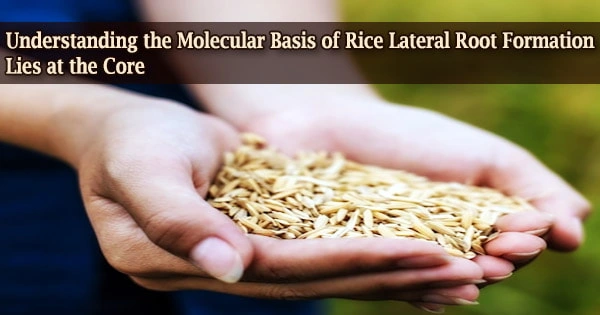Rice plants’ ability to change their root systems to respond to surrounding soil water conditions is an excellent example of phenotypic plasticity. The actual process behind this, however, remained unknown.
Rice is an edible starchy cereal grain as well as the grass plant (family Poaceae) that produces it. Rice is a staple food for about half of the world’s population, including virtually all of East and Southeast Asia; humans consume 95 percent of the world’s rice production.
The significance of two WUSCHEL-related homeobox (WOX) genes in modulating the root primordium size in lateral roots has now been discovered by an international collaboration of Japanese, Australian, and Filipino researchers.
Cultivated rice is an annual grass that grows to a height of around 1.2 meters (4 feet). The long, flattened leaves are carried on hollow stems. Fibrous root systems are frequently large and spreading.
The panicle, also known as an inflorescence (flower cluster), is made up of spikelets that carry flowers and generate the fruit, or grain. The length, form, and weight of the panicle, as well as the total output of a plant, vary substantially between varieties.
Rice plants normally produce two types of lateral roots that arise from the primary root: the S-type, which is short and thin, and the L-type, which is longer and thicker. The phenotypic difference confers differing abilities: the L-type lateral root system is more suited for water uptake under drought or osmotic stress.
The diameter of the lateral root system during the root primordium stage determines the kind of lateral root system (or the root tissue at its earliest stage of development). However, the chemical basis for these primordium size disparities was unknown.
A team of Nagoya University researchers led by Tsubasa Kawai, Akira Yamauchi, and Yoshiaki Inukai aimed to get a deeper knowledge of the genetic variables controlling the lateral root primordium size in rice in a recent study published in the Proceedings of the National Academy of Sciences.
Speaking about the importance of their study, Prof. Yamauchi states, “As the lateral root type determined by its primordium size is an important phenotypic trait for the growth and maintenance of rice plants under variable water environments, our study provides important insights for improving rice plant resilience to environmental stresses through plastic root development.”
The researchers used the seminal root in a series of root tip excision tests (a type of embryonic root that is also called the primary root).
They discovered that removing the root tip of a mutant plant with a deficiency in the gene for S-type roots resulted in more L-type roots than in wild type plants. This plant’s genetic study found that the QHB/OsWOX5 gene is to blame for the anomaly.
As the lateral root type determined by its primordium size is an important phenotypic trait for the growth and maintenance of rice plants under variable water environments, our study provides important insights for improving rice plant resilience to environmental stresses through plastic root development.
Prof. Akira Yamauchi
The researchers discovered that OsWOX10, a WOX protein gene, was overexpressed in the L-type roots after further investigation.
Overexpression of OsWOX10 increased the diameter of L-type roots, and mutations in this gene impacted the thickness of L-type lateral roots, indicating that it plays a role in mediating L-type root formation, according to the researchers. Its expression was discovered to be inversely connected to QHB activity, with QHB mutations causing an increase in L-type LR in the WT strain.
They concluded that two major WOX family genes, QHB and OsWOX10, which were discovered to have opposing regulatory roles, were indeed influencing the primordial size of the lateral roots based on these findings.
Prof. Inukai is hopeful of the potential applications of this discovery, adding, “Improving root phenotypic plasticity is key to better crop production with more efficient water acquisition. Our findings may lead to the development of unprecedented rice varieties with drought stress tolerance and contribute to securing sustainable rice production for growing population in the world.”





